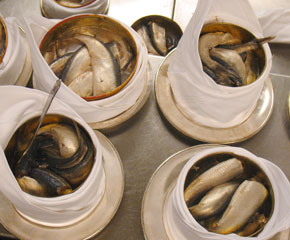Every year in August, Swedes gather with friends and family to celebrate the start of the season for fermented Baltic herring, or surstroemming as it is called in Swedish.
The dish is known for its pungent odour &ndash some compare it to the smell of a wet dog, others pinch their nose at the mere thought of it &ndash and is a northern Swedish specialty that people either love or hate.
The herring fillets are served with boiled new potatoes, freshly chopped onions and sour cream, all wrapped up in a wafer thin soft bread and washed down with generous amounts of aquavit or beer, though purists insists milk is the way to go.
The tradition dates back several centuries when fish could only be caught during a few short months because of the ice-covered northern waters, and fermenting it was a smart and economical preservation method to enable Swedes to eat fish year round.
Nowadays, the waters rarely freeze and modern technology means herring can be fished all year, but the tradition lives on and is so popular that a special Academy and even a museum have been dedicated to the dish.
The fermentation procedure is the following: the herring is caught in late spring, then placed in a salt mixture in wooden barrels for several days. It is then moved into the sun, which shines almost around the clock in the north in summer, for a few months to ferment.
After that it is shipped to stores in small tins.
It’s only sold in shops as of the third Thursday in August, in order to allow for the proper fermentation period.
Apartment dwellers are advised to open the tins outdoors to avoid a lasting stench in their building.

